Blog
Mar 29th, 2015
Bison Behavior and Survival
Despite appearances to the contrary, Bison are strong swimmers and cross the hefty Yellowstone River without hesitation. They enter the current and swim directly across with geometric economy, exiting the other bank in the shortest distance. Bison tend to favor specific crossing sites year after year, regardless of season or conditions.
The winter of 2015 was unusually mild for Hayden Valley, with the first Grizzly spotted in mid February, several weeks earlier than most years. The Yellowstone River for the most part flowed wider than normal. Days of subzero temperatures were followed by days of warmer air that sent the ice along the river into retreat only to advance again in the bitter cold of the night. The width of the river and extent of the ice changed like the tides.
By February 20, in a shallow bend of the river about 100 yards downstream of one of the favored crossing sites, six bison carcasses lay tangled and frozen. A few ravens and bald eagles picked at the portions above the water, but for the most part the carcasses were intact and as solid as concrete.
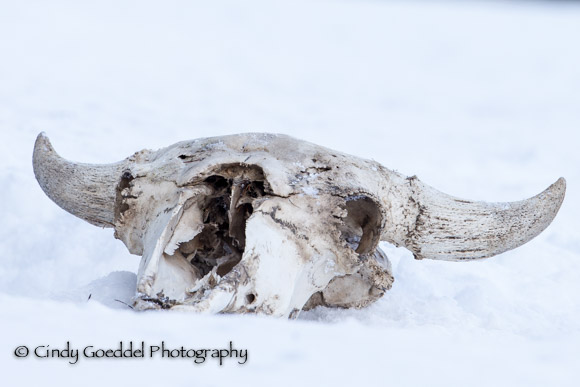
We snow-shoed in to take a closer look at the carnage and found an old bison skull on the bank, and I promptly remembered the Spring before photographing a Grizzly on a bison carcass in the same area of the river. Perhaps this crossing is good in three seasons out of the four. While watching the birds and pondering the scene in front of me, two bull bison appeared out of the trees across the river from us several hundred yards upstream and proceeded to the crossing spot 100 yards upstream from the carcasses. The bull in the lead was older, larger and evidently wise. He stopped on the thick ice near the shore and looked across the dark river at the ice on the opposite bank and then slowly turned back to the snow on shore and moved downstream, not stopping again until he was almost directly in line with the carcasses. There he began his crossing, the smaller bull following. The ice did not cover the edges of the river here, nor was the water so deep that they had to swim. The bulls crossed easily and without incident, although they did cast anxious looks at their brethren on their way past. They clambered out, shook the water from their thick fur and walked along a bison trail into the trees and up towards the road.
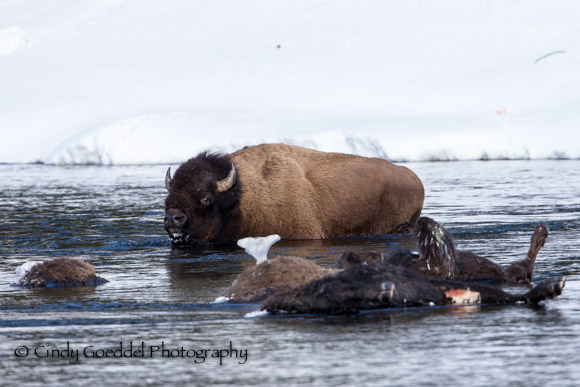
The following evening we stopped our snow-coach where we could see the carcasses. Upstream, at the crossing spot, was a bull bison standing near or on the ice looking across the river. Two coyotes appeared out of the trees and moved towards the old bull. He did not budge. The coyotes pushed harder and the bull took a half step and both the bison and the ice held firm. The coyotes continued on their opportunistic way. Had the coyotes tried this maneuver before? Had the tricksters learned to herd the bison to their watery grave? How many, if any of the six dead downstream were the direct result of the coyotes?
We decided to watch the bull a bit longer and sat in the coach with binoculars raised as the light faded. Suddenly the ice broke and the bison disappeared into the inky river. He was completely submerged, but came up and began swimming the most direct route to the other side where he encountered a thick barrier of ice well before his hooves could touch the rocky bottom. Only his massive head was above water as he tried repeatedly and without success to break/swim through the ice that had abruptly brought his crossing and maybe his life, to an end.
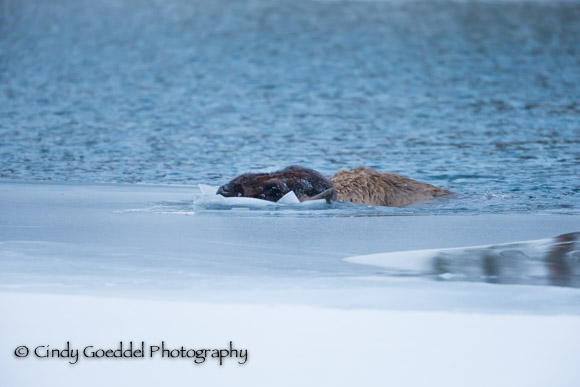
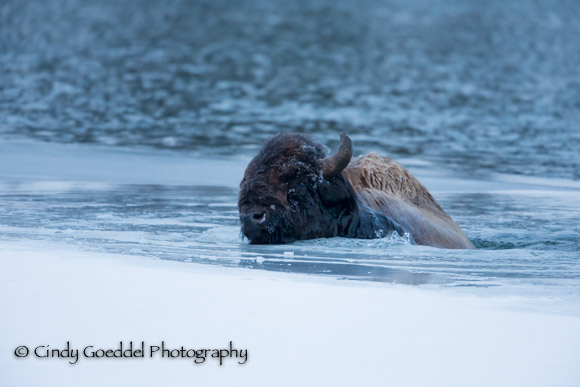
I jumped out of the coach to photograph, the clients declined. I tried to shake the thought that I was photographing number seven. After a few long distance photographs, I remembered the snow-shoe trail we had made the day before and set off down the hard-packed trail in the waning light to document the struggle for survival. I could hear his labored breathing and see his nostrils flaring with effort. He used his head like a battering ram against the ice, but he was unable to break through. By now he had been in the icy water for nearly 20 minutes and he was tiring. His thick fur was icing up in the cold. The ravens abruptly got noisy as if they were telegraphing the soon arrival of a seventh carcass. The bison determinedly kept trying to break though the ice and come ashore directly, but it was hopeless, he was losing the battle. I knew if he turned and swam downstream 100 yards he could come ashore easily like the bison had the day before. What if I moved closer, would my unwelcome presence move him downstream to safety?
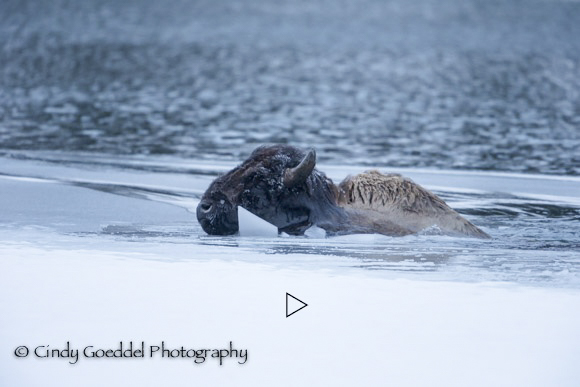
It was late and I was alone with six carcasses, a drowning bison and ravens loudly publicizing the whole ordeal. I had forgotten my bear spray and I was a bit jumpy, especially when I heard a twig snap. It was Daniel, my friend, my colleague and my driver. He had decided to join me in an act of support. We agreed my idea was worth a try. We moved directly towards the fatiguing bull and he immediately turned away.
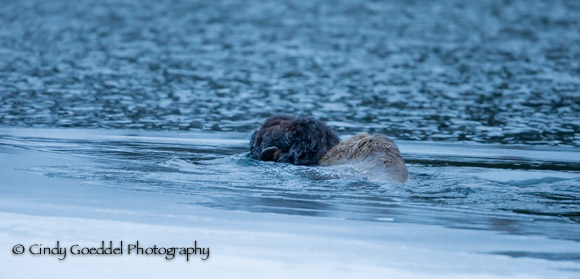
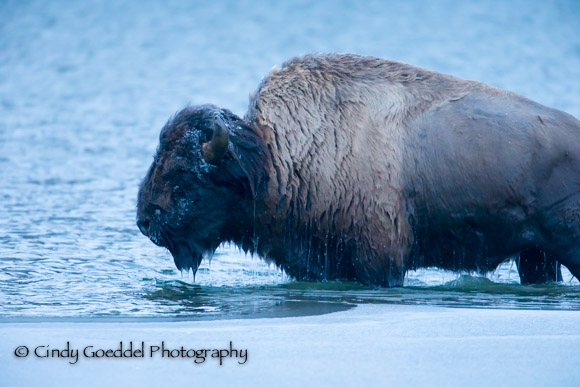
Swimming downstream, he gained his footing and slowly labored up and out of the river and stood dripping and exhausted in the cold. Dan and I cheered and then held our breath, waiting for the old guy to summon up the energy to shake. Finally, he tentatively shook just his head and then, a few seconds later, he shook his whole body more vigorously.
Walking in the trail of the other bison, he disappeared into the trees.
Blogging the Blog - National Wildlife Week
Winter Highlights Report
Recent Entries
- How to become a better wildlife photographer in your own back yard.
- Five Reasons Why I Shoot in Manual Exposure Mode
- Capturing Winter Wonder
- The Artist’s Eye
- Icy Dispatch
- Blogging the Blog - National Wildlife Week
- Bison Behavior and Survival
- Winter Highlights Report
- Coyote Climbs Tree and Steals Bobcat’s Duck!
- Bobcat!
- Hoodoos, Vines & Lost Boys
- African Sky

